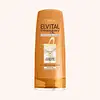Kundal Protein Bonding Care Shampoo Versus L'Oreal Elvital Extraordinary Coconut Oil Conditioner Extra-Fine
What's inside
What's inside
 Key Ingredients
Key Ingredients

 Benefits
Benefits

 Concerns
Concerns

 Ingredients Side-by-side
Ingredients Side-by-side

Water
Skin ConditioningSodium C14-16 Olefin Sulfonate
CleansingCocamidopropyl Betaine
CleansingCocamide Mea
EmulsifyingGlycol Distearate
EmollientSodium Chloride
MaskingGlycerin
HumectantTetradecene
EmollientHydroxyacetophenone
AntioxidantCitric Acid
BufferingHexadecene
SolventPolyquaternium-10
Oenothera Biennis Flower Extract
AstringentButylene Glycol
HumectantEthylhexylglycerin
Skin ConditioningPolyquaternium-7
Guar Hydroxypropyltrimonium Chloride
Skin ConditioningDisodium EDTA
1,2-Hexanediol
Skin ConditioningSodium Benzoate
MaskingMaltodextrin
AbsorbentOcimum Sanctum Leaf Extract
Skin ConditioningHibiscus Syriacus Flower Extract
AntioxidantChlorella Vulgaris Extract
Skin ConditioningPropanediol
SolventHydrolyzed Soy Protein
HumectantHydrolyzed Wheat Protein
Skin ConditioningHydrolyzed Corn Protein
Skin ConditioningGlycine
BufferingSerine
MaskingGlutamic Acid
HumectantBenzyl Glycol
SolventAspartic Acid
MaskingLeucine
Skin ConditioningHydrolyzed Glycosaminoglycans
HumectantSodium Hyaluronate
HumectantAlanine
MaskingLysine
Skin ConditioningArginine
MaskingTyrosine
MaskingPhenylalanine
MaskingThreonine
Proline
Skin ConditioningValine
MaskingIsoleucine
Skin ConditioningHistidine
HumectantMethionine
Skin ConditioningCysteine
AntioxidantSodium Hyaluronate Crosspolymer
HumectantHydrolyzed Hyaluronic Acid
HumectantHydroxypropyltrimonium Hyaluronate
Hyaluronic Acid
HumectantSodium Acetylated Hyaluronate
HumectantParfum
MaskingAlpha-Isomethyl Ionone
PerfumingCitronellol
PerfumingLimonene
PerfumingHexyl Cinnamal
PerfumingLinalool
PerfumingWater, Sodium C14-16 Olefin Sulfonate, Cocamidopropyl Betaine, Cocamide Mea, Glycol Distearate, Sodium Chloride, Glycerin, Tetradecene, Hydroxyacetophenone, Citric Acid, Hexadecene, Polyquaternium-10, Oenothera Biennis Flower Extract, Butylene Glycol, Ethylhexylglycerin, Polyquaternium-7, Guar Hydroxypropyltrimonium Chloride, Disodium EDTA, 1,2-Hexanediol, Sodium Benzoate, Maltodextrin, Ocimum Sanctum Leaf Extract, Hibiscus Syriacus Flower Extract, Chlorella Vulgaris Extract, Propanediol, Hydrolyzed Soy Protein, Hydrolyzed Wheat Protein, Hydrolyzed Corn Protein, Glycine, Serine, Glutamic Acid, Benzyl Glycol, Aspartic Acid, Leucine, Hydrolyzed Glycosaminoglycans, Sodium Hyaluronate, Alanine, Lysine, Arginine, Tyrosine, Phenylalanine, Threonine, Proline, Valine, Isoleucine, Histidine, Methionine, Cysteine, Sodium Hyaluronate Crosspolymer, Hydrolyzed Hyaluronic Acid, Hydroxypropyltrimonium Hyaluronate, Hyaluronic Acid, Sodium Acetylated Hyaluronate, Parfum, Alpha-Isomethyl Ionone, Citronellol, Limonene, Hexyl Cinnamal, Linalool
Water
Skin ConditioningCetearyl Alcohol
EmollientBehentrimonium Chloride
PreservativeParfum
MaskingCetyl Esters
EmollientCI 19140
Cosmetic ColorantCocos Nucifera Oil
MaskingPhenoxyethanol
PreservativeTrideceth-6
EmulsifyingDilauryl Thiodipropionate
AntioxidantChlorhexidine Digluconate
AntimicrobialLinalool
PerfumingBenzyl Benzoate
AntimicrobialAmodimethicone
Isopropyl Alcohol
SolventCaramel
Cosmetic ColorantCitric Acid
BufferingPotassium Hydroxide
BufferingCetrimonium Chloride
AntimicrobialCoumarin
PerfumingHexyl Cinnamal
PerfumingCeramide AP
Skin ConditioningWater, Cetearyl Alcohol, Behentrimonium Chloride, Parfum, Cetyl Esters, CI 19140, Cocos Nucifera Oil, Phenoxyethanol, Trideceth-6, Dilauryl Thiodipropionate, Chlorhexidine Digluconate, Linalool, Benzyl Benzoate, Amodimethicone, Isopropyl Alcohol, Caramel, Citric Acid, Potassium Hydroxide, Cetrimonium Chloride, Coumarin, Hexyl Cinnamal, Ceramide AP
Ingredients Explained
These ingredients are found in both products.
Ingredients higher up in an ingredient list are typically present in a larger amount.
Citric Acid is an alpha hydroxy acid (AHA) naturally found in citrus fruits like oranges, lemons, and limes.
Like other AHAs, citric acid can exfoliate skin by breaking down the bonds that hold dead skin cells together. This helps reveal smoother and brighter skin underneath.
However, this exfoliating effect only happens at high concentrations (20%) which can be hard to find in cosmetic products.
Due to this, citric acid is usually included in small amounts as a pH adjuster. This helps keep products slightly more acidic and compatible with skin's natural pH.
In skincare formulas, citric acid can:
While it can provide some skin benefits, research shows lactic acid and glycolic acid are generally more effective and less irritating exfoliants.
Most citric acid used in skincare today is made by fermenting sugars (usually from molasses). This synthetic version is identical to the natural citrus form but easier to stabilize and use in formulations.
Read more about some other popular AHA's here:
Learn more about Citric AcidHexyl Cinnamal is a fragrance ingredient with a similar scent to jasmine. It can be naturally found in chamomile essential oil.
This ingredient is a known EU allergen and may sensitize the skin. The EU requires this ingredient to be listed separately on an ingredients list.
Hexyl Cinnamal is not water soluble but is soluble in oils.
Learn more about Hexyl CinnamalLinalool is a fragrance and helps add scent to products. It's derived from common plants such as cinnamon, mint, citrus, and lavender.
Like Limonene, this ingredient oxidizes when exposed to air. Oxidized linalool can cause allergies and skin sensitivity.
This ingredient has a scent that is floral, spicy tropical, and citrus-like.
Learn more about LinaloolParfum is a catch-all term for an ingredient or more that is used to give a scent to products.
Also called "fragrance", this ingredient can be a blend of hundreds of chemicals or plant oils. This means every product with "fragrance" or "parfum" in the ingredients list is a different mixture.
For instance, Habanolide is a proprietary trade name for a specific aroma chemical. When used as a fragrance ingredient in cosmetics, most aroma chemicals fall under the broad labeling category of “FRAGRANCE” or “PARFUM” according to EU and US regulations.
The term 'parfum' or 'fragrance' is not regulated in many countries. In many cases, it is up to the brand to define this term.
For instance, many brands choose to label themselves as "fragrance-free" because they are not using synthetic fragrances. However, their products may still contain ingredients such as essential oils that are considered a fragrance by INCI standards.
One example is Calendula flower extract. Calendula is an essential oil that still imparts a scent or 'fragrance'.
Depending on the blend, the ingredients in the mixture can cause allergies and sensitivities on the skin. Some ingredients that are known EU allergens include linalool and citronellol.
Parfum can also be used to mask or cover an unpleasant scent.
The bottom line is: not all fragrances/parfum/ingredients are created equally. If you are worried about fragrances, we recommend taking a closer look at an ingredient. And of course, we always recommend speaking with a professional.
Learn more about ParfumWater. It's the most common cosmetic ingredient of all. You'll usually see it at the top of ingredient lists, meaning that it makes up the largest part of the product.
So why is it so popular? Water most often acts as a solvent - this means that it helps dissolve other ingredients into the formulation.
You'll also recognize water as that liquid we all need to stay alive. If you see this, drink a glass of water. Stay hydrated!
Learn more about Water